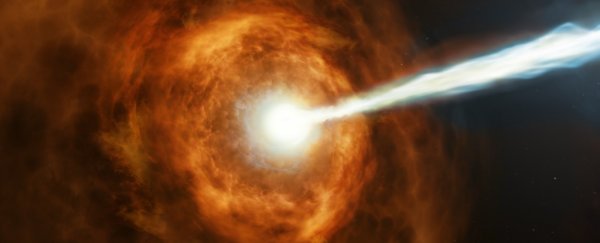The popular conception goes that nothing can escape from a black hole. Once something passes the event horizon - the so-called point of no return - it stays there, forever, bound by a gravitational field not even light can escape.
But a rotating black hole generates vast amounts of energy, which, theoretically, can be extracted from the ergosphere, a region that sits just on the outside of the event horizon. This has been shown both theoretically and experimentally - and now a team of astrophysicists has found what they believe is observational evidence for it.
The smoking gun is the most powerful gamma-ray burst we've ever detected, GRB 190114C, a colossal flare clocking in at around a trillion electron volts (1 TeV), from 4.5 billion light-years away.
"Gamma-ray bursts, the most powerful transient objects in the sky, release energies of up to a few 1054 erg in just a few seconds," said astrophysicist Remo Ruffini of the International Center for Relativistic Astrophysics Network (ICRANet) headquartered in Italy.
"Their luminosity in the gamma-rays, in the time interval of the event, is as large as the luminosity of all the stars of the observable Universe! Gamma-ray bursts have been thought to be powered, by an up-to-now unknown mechanism, by stellar-mass black holes."
Last year, Ruffini and his colleagues came up with a solution for this mechanism - a process they have called a binary-driven hypernova.
It starts with a close binary system consisting of a carbon-oxygen star at the end of its life, and a neutron star. When the carbon-oxygen star goes supernova, the material ejected can be rapidly slurped up by the companion neutron star. Thus, that companion passes the critical mass point and collapses into a black hole, which launches a burst of gamma rays, as well as jets of material from its poles at nearly light-speed.
(The core of the carbon-oxygen star collapses into a second neutron star, resulting in a black hole-neutron star binary.)
Now, in a new paper, Ruffini and his colleagues led by ICRANet's Rahim Moradi have described the mechanism that can launch such a high-energy gamma-ray burst: the acceleration of particles along magnetic field lines inherited from the black hole's parent neutron star. That magnetic field extracts rotational energy from the black hole's ergosphere.
"The novel engine presented in the new publication," Ruffini explained, "makes the job through a purely general relativistic, gravito-electrodynamical process: a rotating black hole, interacting with a surrounding magnetic field, creates an electric field that accelerates ambient electrons to ultrahigh-energies leading to high-energy radiation and ultrahigh-energy cosmic rays."
Relativistic, or near light-speed, jets are not uncommon in active galactic nuclei, the supermassive black hole monsters at the cores of galaxies. These jets are thought to form from the accretion process, which goes as follows.
A huge disk of material swirls around the active black hole, falling into it from the inner edge, but not all of this material falls onto the black hole. Some of it, astronomers believe, is funneled and accelerated along magnetic field lines around the outside of the black hole to the poles, where it is launched into space in the form of collimated jets.
We know black holes and neutron stars can have powerful magnetic fields, and the evidence suggests these can act as a synchrotron (a type of particle accelerator). Evidence also suggests that a magnetic field synchrotron plays a role in launching a gamma-ray burst during the formation of a black hole.
Studying GRB 190114C, Moradi and his team have found a similar mechanism - but, rather than a continuous emission process, it's discrete, repeating over and over, releasing each time a quantum of black hole energy to produce the observed gamma-ray emission following the gamma-ray burst.
Based on observations of GRB 190114C, the team was able to reconstruct the sequence of events.
The carbon-oxygen star goes supernova, while the core collapses into a neutron star; some of that ejected material falls back onto the newly formed neutron star, producing an X-ray glow - as observed by the Swift telescope.
Some of the material also falls onto the neutron star companion, pushing it over the mass limit to form a black hole - this process would have been smooth, taking just 1.99 seconds. Then material continues to fall onto the newly formed black hole, producing a gamma-ray burst from 1.99 to 3.99 seconds.
Finally, more material falling onto the black hole results in the formation of jets, and gamma radiation in the gigaelectronvolt range, from the extraction of rotational energy.
Other scientists may disagree with the findings; a team last year found that the gamma-ray burst was the result of a collapsing magnetic field, for instance. It may not even apply to all gamma-ray bursts. Nevertheless, all the parts seem to fit the observations of GRB 190114C very neatly.
"The proof that we can use the extractable rotational energy of a black hole to explain the high-energy jetted emissions of gamma-ray bursts and active galactic nuclei stands alone," Ruffini said.
"A long march of successive theoretical progress and new physics discovered using observations of GRBs has brought to this result which has been [awaited] for about 50 years of relativistic astrophysics."
The research has been published in Astronomy & Astrophysics.
